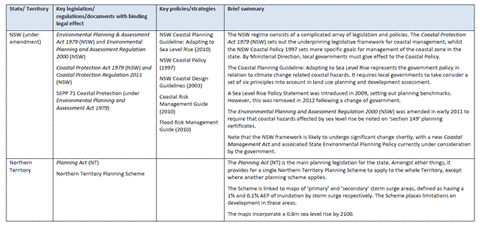You are here
Different planning approaches across jurisdictions
Differences in planning laws and policy in different states and territories impact on how councils can plan for climate change.
At a glance
Each Australian state and territory has developed its own process for planning along the coast. Different histories of development and priorities have shaped these approaches and the set of legislation that controls them. As a consequence, each jurisdiction has a different set of constraints and pathways to climate change adaptation planning. Several states have adopted sea-level rise benchmarks or planning allowances (i.e. a projected level of sea-level rise), while others have not.
Main text
In all Australian states, local government has primary responsibility for planning decisions, within the context of the relevant state laws. In the Northern Territory, the Northern Territory Government has responsibility for all planning decisions, with local government having only an advisory role.
Each Australian state has a range of statutes, regulations and policies (Table 1) that determine the process and the constraints on local governments undertaking planning along the coast. In this way, state planning schemes can strongly influence how adaptation planning can be undertaken and what options can be considered. The federal government can indirectly influence planning decisions through funding, policy and provision of information, but it has no legislative powers over coastal planning.
There are major differences in the legal approach from state to state. In some states climate change is integrated into general planning law, whilst in other states it is considered under separate policies or legislation. Most states (Victoria, Queensland, Western Australia, South Australia and Tasmania) provide a sea-level rise planning benchmark or planning allowances which local governments must consider in developing local planning schemes and assessing development. New South Wales leaves the selection of a sea-level rise benchmark appropriate to their locality to the discretion of the councils. The Northern Territory has no sea-level rise benchmark.
Consideration of sea-level rise, storm tides and coastal erosion in adaptation planning is largely tied to land use planning and falls to local councils. Depending on the level of discretion granted to local governments by the state, councils often still have the ability create their own approaches to managing risk associated with coastal erosion, sea-level rise, and coastal flooding, provided that they follow state requirements. For more information on legal issues see our content on Reducing the risk of a legal challenge and Information Manual 6: Legal Risk.
Each state/territory government approach presents different benefits and challenges for councils undertaking adaptation in the coastal zone. Sea level benchmarks are one of the key differences. The provision of a benchmark creates certainty for local councils, but is something of a ‘blunt instrument’, with local conditions and variations in risks not fully accounted for. However without a benchmark, considerably more of the complexity and potential risk of decision-making falls to local governments. Local governments may struggle to negotiate with their constituents about the best planning benchmarks; they also may not have sufficient resources to select an appropriate benchmark and translate it into law.
Table 1: Summary of state and Northern Territory policy and law relevant to coastal Australia. Source: Bell-James (pers. comm.) and CoastAdapt.





